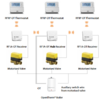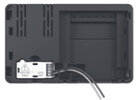Hi everyone
I've read so many forum posts here but I can't seem to find an answer to my current conundrum... thanks in advance for any help you can offer!
I'd like to install a Drayton Wiser 3 kit for the house.
Current set up is 2 central heating zones (upstairs/downstairs) and hot water, with a conventional boiler and unvented indirect cylinder.
We have a Horstmann H37XL programmer, 2 x Honeywell DT92E wireless thermostats (upstairs/downstairs) and 2 x BDR91 (upstairs/downstairs). I can see there are mechanical valves on each pipe circuit but I don't know exactly what is controlling them...
Initially I thought we just needed to replace the H37XL programmer with the Wiser HubR, but then I was unsure what we should do about the existing wireless thermostats. I'm guessing they communicate with the BDRs? And do the BDRs in turn communicate with the boiler and/or the mechanical valves?
If so, by just replacing the H37XL programmer, won't the existing thermostats still be in the loop?
Any advice appreciated here.
Many thanks!
I've read so many forum posts here but I can't seem to find an answer to my current conundrum... thanks in advance for any help you can offer!
I'd like to install a Drayton Wiser 3 kit for the house.
Current set up is 2 central heating zones (upstairs/downstairs) and hot water, with a conventional boiler and unvented indirect cylinder.
We have a Horstmann H37XL programmer, 2 x Honeywell DT92E wireless thermostats (upstairs/downstairs) and 2 x BDR91 (upstairs/downstairs). I can see there are mechanical valves on each pipe circuit but I don't know exactly what is controlling them...
Initially I thought we just needed to replace the H37XL programmer with the Wiser HubR, but then I was unsure what we should do about the existing wireless thermostats. I'm guessing they communicate with the BDRs? And do the BDRs in turn communicate with the boiler and/or the mechanical valves?
If so, by just replacing the H37XL programmer, won't the existing thermostats still be in the loop?
Any advice appreciated here.
Many thanks!



